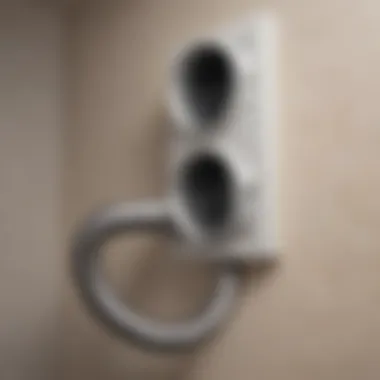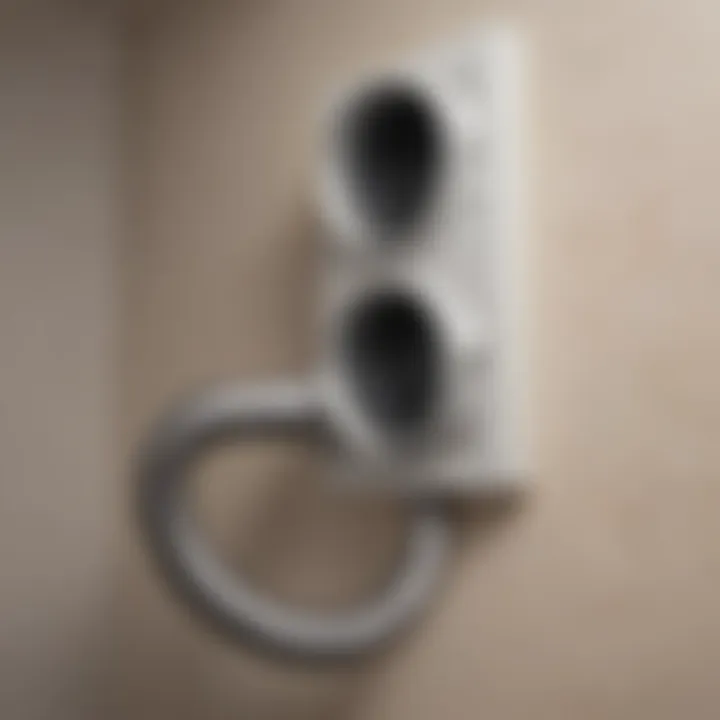Understanding Clogged Dryer Vents and Efficiency


Intro
In the realm of home maintenance, the significance of dryer vent care often goes overlooked. A clogged dryer vent presents not only a challenge to effective laundry drying but also raises serious safety concerns. Understanding the implications of vent blockages becomes essential for homeowners seeking to optimize their drying efficiency and safety.
Dryers rely heavily on the proper airflow provided by unobstructed vents. When lint, debris, or other obstructions accumulate, dryers must work harder, leading to inefficient operations and potential appliance damage. This article proceeds to explore the mechanics of dryer vents, identifies signs of clogs, and advocates for routine maintenance to enhance performance.
Through careful examination, we aim to promote awareness of dryer vent care and its impact, ultimately empowering homeowners to take proactive measures to safeguard their appliances and homes.
Preface
The efficiency of a clothes dryer heavily relies on the functionality of its vent. A clogged dryer vent can significantly reduce drying efficiency, leading to longer drying times and higher energy consumption. Many homeowners overlook this aspect, not realizing the critical role a vent plays in ensuring proper airflow.
Understanding the importance of a clear dryer vent starts with recognizing its role in the drying process. When clothes are loaded into the dryer, moisture from the fabrics needs to be expelled effectively. This is where the vent comes into play. A well-functioning vent allows moisture-laden air to escape, enabling the dryer to work efficiently.
Failing to maintain this system can lead to a host of problems. Not only does it impact the drying performance, but it also raises the risk of safety hazards. The drying appliance may work harder, leading to increased wear and tear. Consequently, it may require repairs which can be expensive and disruptive.
Moreover, a clogged vent contributes to energy inefficiency, translating to higher utility expenses each month. Recognizing these factors is essential for homeowners who wish to optimize appliance performance and maintain safety.
In this article, we will examine the mechanics of dryer vents, the signs indicating clogs, and the implications on performance and safety. We will provide insights into how to prevent clogs through regular maintenance. Understanding all these facets equips homeowners with the knowledge to improve their dryer’s efficiency and longevity.
The Function of a Dryer Vent
The dryer vent plays a critical role in the overall functionality of a clothes dryer. This system is designed to expel hot, moist air generated during the drying process outside of your home. Thus, it helps maintain an efficient drying cycle by allowing the dryer to operate without accumulating excessive humidity. Furthermore, good dryer vent performance is essential for energy efficiency, as it ensures that the dryer can effectively remove moisture from wet clothes.
An efficient dryer vent system contributes to faster drying times and saves energy during the drying process. The vent permits the necessary airflow that allows moisture-laden air to escape while drawing fresh air into the dryer drum. This airflow is not just critical for drying clothes but also for preventing the buildup of lint and debris within the vent itself. Keeping the vent clear minimizes the risk of clogs that can lead to various operational issues.
Airflow and Drying Mechanism
The core mechanism of clothes drying hinges upon the movement of air. As the dryer runs, it generates heat which evaporates moisture from fabrics. The resulting vapor needs a clear path to escape; this is where the dryer vent becomes vital. If the airflow is restricted due to a clog or blockage, the dryer cannot expel the moisture quickly enough.
The consequences of restricted airflow are significant. For example, clothes take longer to dry, forcing the machine to run longer and increasing energy consumption. This inefficiency may lead to premature wear on the dryer components and contribute to a higher utility bill. Furthermore, noticeable changes in the drying cycle, such as soggy clothes after a full cycle, signal that airflow may be impeded.
Materials and Design of Dryer Vents
Understanding the materials and design elements of dryer vents can provide insight into their effectiveness. Most dryer vents are constructed from either flexible aluminum or galvanized steel. Each material has advantages, but aluminum is often favored for its lightweight nature and resistance to corrosion.
Another essential aspect of dryer vent design is its length and the number of turns it makes. A short, straight venting path is ideal, as every bend or curve introduces resistance and can reduce airflow. Additionally, vents should ideally be as short as possible to promote efficient moisture extraction. Improper installation can also contribute to problems, making it necessary to ensure that vents are installed according to the manufacturer's specifications.


In summary, recognizing the function of a dryer vent is paramount. An understanding of its role in airflow and the choice of materials could lead to better maintenance practices, ultimately enhancing the dryer’s efficiency and lifespan.
Signs of a Clogged Dryer Vent
Recognizing when a dryer vent is clogged is crucial for maintaining appliance efficiency. Understanding these signs can prevent escalation of dryer issues. Various indicators point to a blockage, and spotting them early enables proactive measures. Inadequate drying performance, unusual odors, excessive heat from the appliance, and lint accumulation are key signs to monitor.
Inadequate Drying Performance
One of the most apparent signs of a clogged dryer vent is inadequate drying performance. When the vent is obstructed, moist air cannot escape effectively. Consequently, clothes may come out damp even after a full drying cycle. This not only frustrates users but also indicates a potential malfunctioning dryer. Timely detection of poor performance allows for maintenance, enhancing both efficiency and longevity of the appliance.
Unusual Odors
Another warning signal is the appearance of unusual odors. A clogged vent traps moisture inside the dryer, leading to mold growth. This moisture can result in musty smells that permeate your laundry space. Such odors not only affect clothing but also can indicate health risks related to mold exposure. If you notice these scents, it's important to investigate promptly. Ensuring good ventilation maintains a fresh laundry environment and improves overall air quality in the home.
Excessive Heat from the Dryer
Excessive heat emanating from the dryer is also a significant concern. A clog can restrict airflow, causing the dryer to overheat during operation. This situation poses not only an efficiency issue but also a safety risk. Appliances that operate continuously at high temperatures can lead to equipment failure and increase the likelihood of fire hazards. Observing temperature changes during drying should prompt an inspection of the dryer vent.
Lint Accumulation in the Area
Finally, lint accumulation around the dryer is a visible sign of vent obstructions. If you notice an abnormal amount of lint buildup in the vicinity of your dryer or on the vent itself, it signals poor airflow. This accumulation can pose both a fire risk and a sign that your drying system is less effective. Regular monitoring and cleaning of lint traps and vents should be a routine practice. This simple habit not only enhances dryer efficiency but also ensures safety around the home.
How Clogs Affect Drying Efficiency
A clogged dryer vent significantly reduces the efficiency of clothes drying processes. Understanding how clogs impact drying efficiency is crucial for homeowners or anyone who uses clothes dryers regularly. Without a clear flow of air, the dryer cannot perform effectively. This inefficiency can lead to longer drying times and elevated energy consumption. Furthermore, the buildup of lint and debris can result in increased wear on the appliance and potential safety hazards.
Restricted Airflow Consequences
When a dryer vent is blocked, it leads to restricted airflow. The operation of a dryer relies heavily on the movement of air to carry moisture from wet clothes. If air cannot circulate properly, several issues may arise:
- Inefficient Drying: Clothes take much longer to dry. This can require multiple cycles, leading to frustration and wasted time.
- Heat Buildup: Mechanical components may overheat due to the inability to vent hot air away from the appliance. This can be harmful to both the dryer itself and the surrounding area.
- Increased Risk of Breakdowns: Equipment under stress from overheating is likely to experience mechanical failures.
It is vital to regularly check the dryer vent for clogs. Cleaning the vent can mitigate the risks of inefficiency and potential damage.
Increased Energy Consumption
A dryer that faces airflow restrictions must work harder to dry clothes, which leads to increased energy consumption. Here are some points to consider:
- Higher Electricity Bills: Extended drying times result in higher energy costs. This can lead to unexpected increases in monthly expenses.
- Environmental Impact: Increased energy usage contributes more to environmental strain. Reducing energy waste not only saves money, but also contributes positively to sustainability efforts.
- Cost of Maintenance: Frequent service calls might be necessary to fix mechanical issues caused by poor airflow. Regular maintenance can prove to be a worthwhile investment.


In summary, understanding how clogs affect dryer efficiency is essential. It not only aids in preventing potential appliance failure but also helps save on operating costs.
Homeowners should prioritize regular maintenance and inspection to ensure their dryer vents remain clear.
Taking these steps can lead to a more efficient drying process and overall safety.
Health and Safety Risks
Understanding the health and safety risks associated with clogged dryer vents is crucial for maintaining a safe home environment. Clogs can lead to severe consequences that extend beyond inefficient drying. The focus on health and safety in relation to dryer vent maintenance not only protects your property but also ensures the well-being of everyone in the household. Failure to address these issues can result in dangerous situations, including fire hazards and mold growth, which can have far-reaching repercussions.
Fire Hazards Linked to Clogs
One of the most pressing dangers associated with a clogged dryer vent is the increased risk of fire. According to the U.S. Fire Administration, dryers account for roughly 2,900 home fires each year, with a significant percentage attributed to clogged vents. When lint accumulation blocks the airflow, the dryer struggles to ventilate properly, causing it to overheat. This overheating can ignite the lint and potentially lead to a destructive fire.
To mitigate this risk:
- Regularly inspect and clean your dryer vent. Lint buildup should be removed to maintain proper airflow.
- Avoid overloading the dryer. This increases the strain on the appliance and can lead to clogs.
- Ensure proper installation. Having the dryer vent installed correctly minimizes the chances of lint accumulation.
It is essential to remain aware of any unusual smells or excessive heat coming from the dryer itself, as these are signs that an obstruction may be present. Immediate action can help prevent fatal accidents.
Mold Growth Due to Moisture Retention
A less recognized but equally concerning issue linked to clogged dryer vents is mold growth. When vents are blocked, humidity and moisture can become trapped inside the dryer and the surrounding area. This excess moisture creates an ideal environment for mold to proliferate, leading to health risks such as respiratory problems, allergies, and skin irritation.
To combat mold growth:
- Maintain clean dryer vents. Routine cleaning can prevent moisture retention and subsequent mold issues.
- Use a dehumidifier. This can help manage humidity levels within your laundry area, limiting mold growth probability.
- Check for signs of water damage. Be vigilant about inspecting your laundry space for dampness and any visible mold.
Keeping up with these precautions not only promotes a healthier living environment but also prolongs the lifespan of your dryer. Immediate attention to these risks is essential for preserving both safety and efficiency.
Preventative Maintenance for Dryer Vents
Preventative maintenance for dryer vents is critical for ensuring dryer efficiency and safety. Regular attention to this aspect not only enhances performance but also minimizes potential hazards. A clean dryer vent leads to improved airflow, which is essential for effective drying. When air can circulate freely, moisture is expelled, and clothes dry more quickly. This results in less energy consumption, as the dryer doesn't have to work overtime to achieve the same drying results.
Additionally, preventative maintenance helps in avoiding costly repairs. Inefficient drying can lead to wear and tear on the machine, ultimately resulting in the need for replacement. By keeping the vent clear, homeowners can extend the life of their dryer and reduce repair expenses.
It is also vital to consider safety when discussing dryer vent maintenance. A blocked vent can cause overheating, increasing the risk of fire. Therefore, establishing a routine for checking and clearing dryer vents is not just wise; it could be lifesaving.


Regular Cleaning Procedures
Implementing regular cleaning procedures for dryer vents is essential. Ideally, this should be done at least once a year, though more frequent cleaning may be necessary depending on usage and household factors. A thorough cleaning involves:
- Removing lint from the lint trap before each load. This simple step can prevent lint from accumulating in the vent.
- Disconnecting the vent duct at least once a year. This allows for a more comprehensive cleaning. Use a vacuum or a specialized dryer vent cleaning brush to remove buildup within the duct.
- Inspecting the outside vent cover for blockages or lint accumulation.
Using these methods prevents significant clogging that compromises drying efficiency.
Professional Inspections: When and Why
While DIY cleaning is beneficial, professional inspections are also important. They should be considered every few years or whenever there are noticeable symptoms of blockage, such as longer drying times or unusual odors. Professional inspections can uncover hidden issues that might not be apparent to homeowners.
Professionals possess specialized equipment, such as high-powered vacuums and camera systems, that can effectively assess the condition of the vent and duct system. They can also identify potential hazards, such as kinks in the ductwork or improper installation that can exacerbate issues. Regular professional maintenance can ensure that the dryer operates efficiently and safely, providing peace of mind for homeowners.
Regular inspections and timely cleaning can significantly enhance dryer performance and safety.
How to Clear a Clogged Dryer Vent
Clearing a clogged dryer vent is crucial for maintaining drying efficiency and ensuring the longevity of the appliance. It prevents energy wastage and minimizes the risk of fire hazards while helping clothes dry more effectively. Neglecting this important task can lead to severe consequences, such as increased energy bills and potential damage to the dryer itself. Therefore, understanding how to properly clear a clogged vent is not only beneficial but necessary for every homeowner.
Tools Needed for Maintenance
Before initiating the cleaning process, it is essential to gather appropriate tools. The right tools make the job easier and more effective. Here are the tools you will typically need:
- Vacuum Cleaner: A vacuum with a long hose attachment helps remove lint and debris from the vent.
- Dryer Vent Cleaning Brush: This specialized brush is designed to reach deep into the vent, effectively dislodging clogs.
- Screwdriver: This tool is helpful for removing vent covers or securing any loose fittings.
- Flathead or Phillips Head: Depending on your dryer, you may need one of these screwdrivers to access the vent.
- Utility Knife: Useful for cutting away any deteriorated duct tape or venting material.
- Safety Glasses and Gloves: Protect yourself while cleaning, as lint can be irritating to the eyes and skin.
- Flashlight: If the vent is lengthy or complex, a flashlight can help illuminate hard-to-see spaces.
By having these tools ready, you set yourself up for a more efficient cleaning process.
Step-by-Step Cleaning Procedure
Cleaning a clogged dryer vent can be methodical and straightforward when broken down into steps. Following these guidelines ensures that the vent is thoroughly cleared and restored to proper function.
- Unplug the Dryer: Always ensure the dryer is disconnected from the power source to prevent any accidents.
- Access the Vent: Move the dryer away from the wall and disconnect the vent hose. Use a screwdriver if necessary to remove any clamps holding the vent in place.
- Inspect the Vent: Look for any visible signs of clogs or damage in the vent. This initial inspection helps identify the extent of the cleaning needed.
- Remove Lint: Using the dryer vent cleaning brush, insert it into the vent and scrub the interior walls. Rotate the brush as you push it in and pull it out to effectively gather lint and debris.
- Vacuum the Vent: Follow up with a vacuum cleaner, ensuring to reach as far into the vent as possible. This aids in removing any loose lint that the brush may have dislodged.
- Clean the Exit Point: Don’t forget to clean the exterior vent where lint can accumulate. This area is often overlooked but crucial for proper airflow.
- Reassemble the Vent: Once everything is clean, reconnect the vent hose securely and push the dryer back into its place. Ensure all fittings are tight to prevent any leaks.
- Plug the Dryer In: After checking that all connections are secure, plug your dryer back into the outlet and run a test cycle.
- Regular Maintenance: Schedule this cleaning periodically, ideally every 6 months, to maintain optimal dryer function and efficiency.
By following these steps, you can effectively clear a clogged dryer vent, ensuring that your appliance operates at its best.
End
The importance of understanding the implications of a clogged dryer vent cannot be overstated. This article has illuminated various aspects of how efficiently a dryer functions, and clarity on such topics can influence not only appliance longevity but also household safety and energy consumption.
A well-maintained dryer vent allows for optimal airflow, which is crucial for efficient drying. When vents are clear, dryers can operate at their intended capacity, minimizing energy usage. In contrast, neglecting maintenance leads to increased drying times and elevated energy bills. This highlights a dual benefit of regular checks: it boosts efficiency while saving costs in the long run.
Moreover, a clogged dryer vent poses significant health and safety risks. The increased potential for fires due to overheating and the possibility of mold growth from moisture accumulation are serious concerns. Thus, awareness of these dangers forms an essential part of home maintenance.
In summary, routine inspections and understanding how to clear or prevent clogs are vital practices. Homeowners can greatly reduce risks and enhance the performance of their dryers by taking these steps seriously. Emphasizing this knowledge empowers individuals, ensuring their household remains both efficient and safe.







